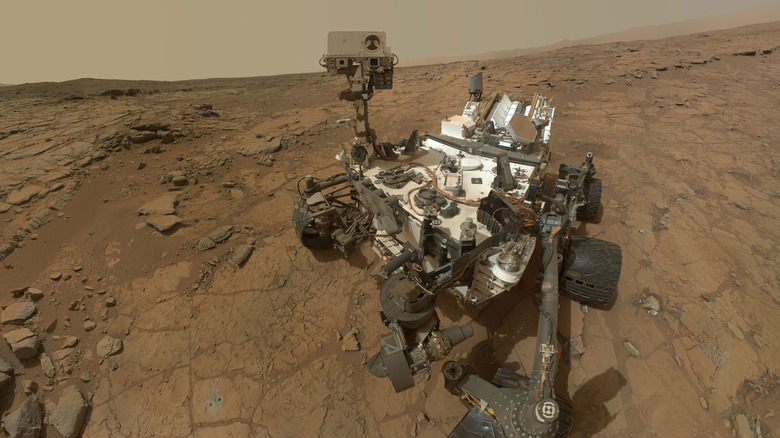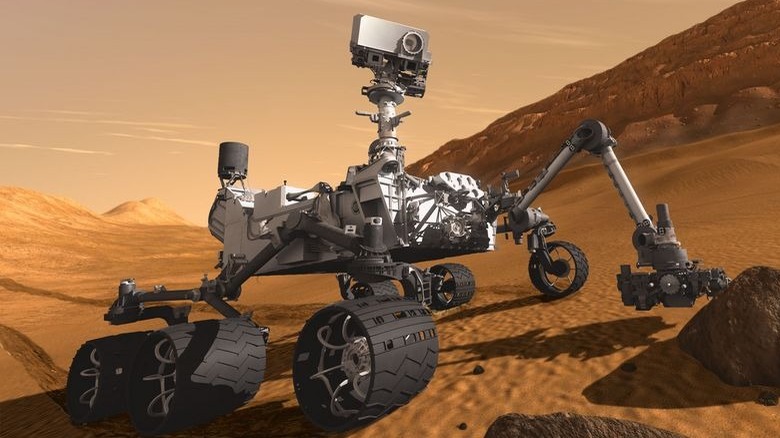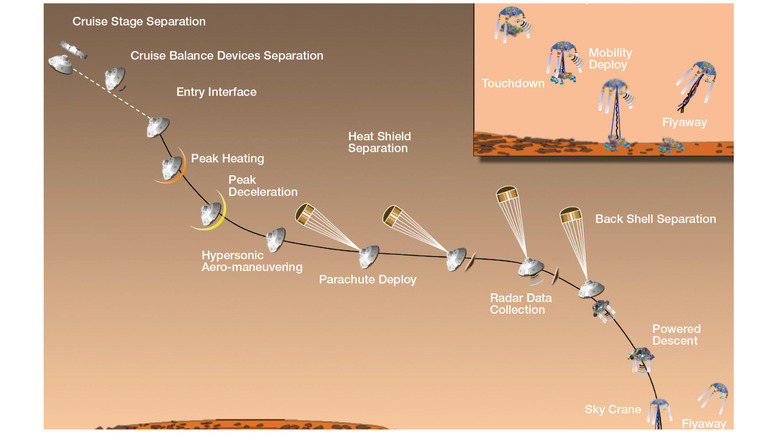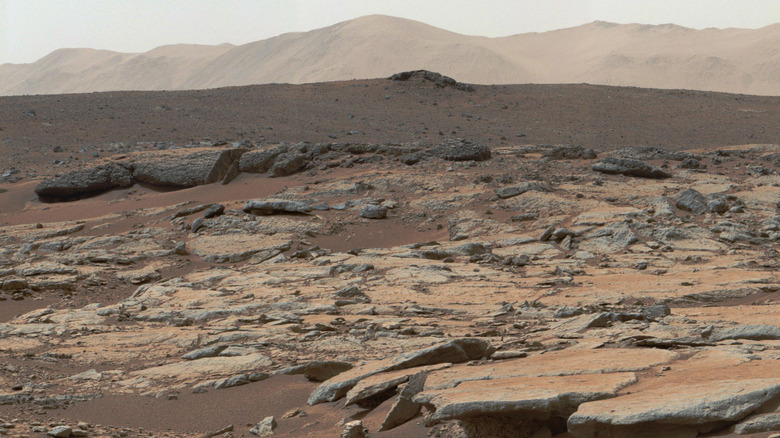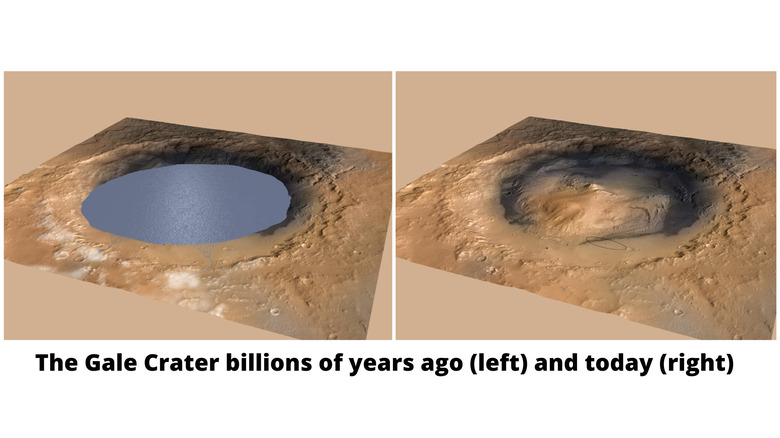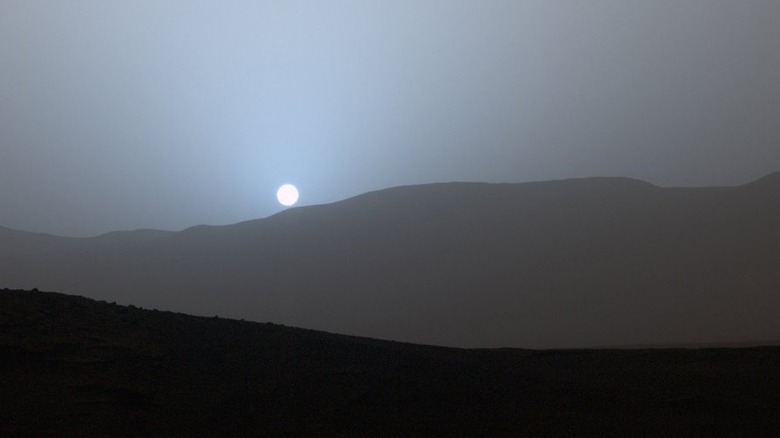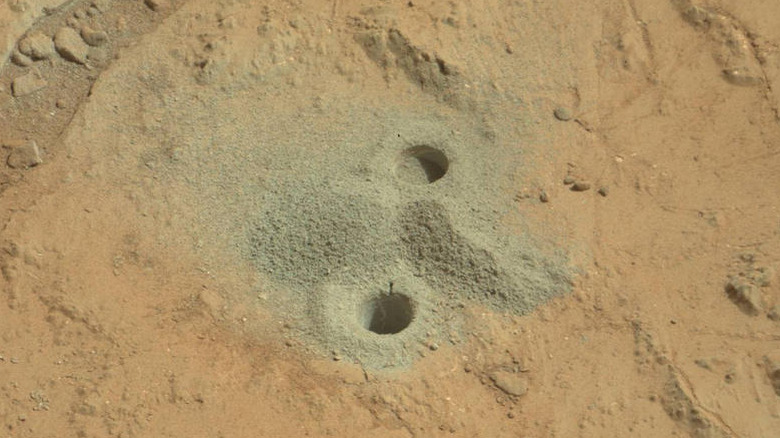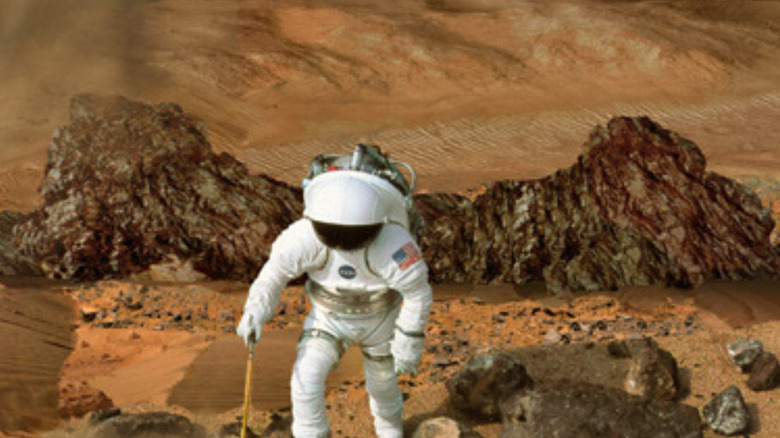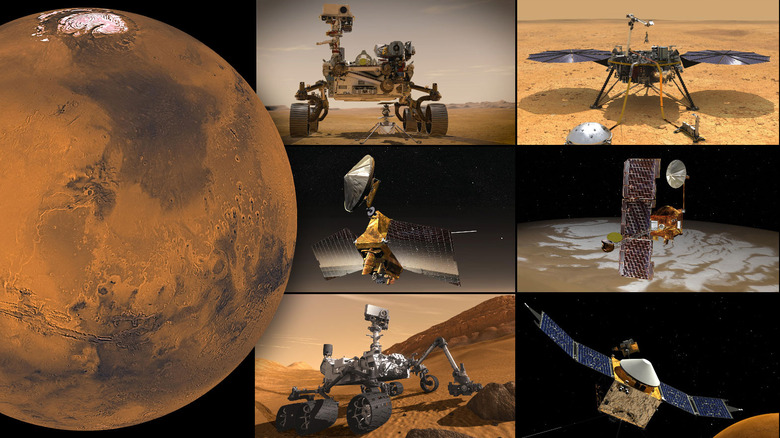10 Years Of The Curiosity Mars Rover
August 2022 marks an important milestone in the exploration of Mars. Ten years ago a pioneering mission landed on the Red Planet tasked with the duty of searching an area called the Gale Crater for signs of geological change — the Curiosity rover. Since its touchdown on the surface of Mars in August 2012 the NASA-operated rover has climbed 2,000 feet over the Gale Crater's 3-mile-high Mount Sharp (via NASA). In the process, Curiosity has snapped almost half a million images, sending back over 3,000 gigabytes of data to Earth. The rover has drilled and scooped over 40 rock and soil samples, spawning research that has been discussed in almost 900 science papers.
During its decade of discovery, the Curiosity rover has been joined on the surface of Mars by fellow rover Perseverance, the Mars helicopter Ingenuity, and the Martian interior probing InSight lander. Together these missions have built a more complete picture of Mars as researchers attempt to discover if Earth's neighbor could have also supported life at some point in its 4.5 billion-year history.
What is Curiosity?
The aptly named Curiosity rover is arguably the largest and most capable rover ever launched by humanity to the surface of Mars. The main objective of the rover is to discover if Mars ever possessed the right environmental conditions to support the existence of simple life forms called microbes. To answer this question, the roughly car-sized rover, which is as tall as a basketball player according to NASA, collects rock, soil, and air samples with tools it manipulates using a 7-foot-long robotic arm.
The relatively large size of Curiosity means it can carry a suite of advanced tools for scientific analysis. These include 17 cameras, a laser it uses to vaporize small rock samples, and a drill to collect powdered rock. These rock samples contain the chemical fingerprint of Mars' geological history via their composition. Also, of particular importance hidden within rocks are their interactions in the past with liquid water.
In addition to this, Curiosity is capable of detecting organic carbon compounds within rock and soil as well as other complex organic molecules that could have — at some point — served as the building blocks for life on the Red Planet. Curiosity's mission was originally only scheduled to last two years, but in December 2012, this was extended indefinitely. As of August 1, 2022, it has been conducting science on Mars for 3,550 Earth days.
Landing on Mars
Even before Curiosity started its operations on the surface of Mars, the mission was making science history. Launched on November 26, 2011, aboard an Atlas V rocket from Cape Canaveral, the rover arrived at the Red Planet eight months later on August 5, 2012. To deposit Curiosity on the surface of Mars, a new landing method was devised.
The first step in this landing procedure saw the spacecraft carrying the rover descend through the atmosphere of Mars by parachute. Just seconds before reaching the Martian surface the landing system fired rockets that allowed it to briefly hover. As this happened a tether slowly and carefully lowered Curiosity to the planet. As the rover touched down on its wheels, the tether was cut, releasing Curiosity. The landing system then flew away before crash landing at a safe enough distance away from the rover. The trial of this new landing method with Curiosity demonstrated two significant things; the ability to land a large and heavy rover on the surface of Mars — something that would come in useful when the same method was used to land Perseverance — and the ability to pinpoint a landing in a precise 12.4-mile wide landing area in the Gale Crater.
But, why was this region chosen to be Curiosity's stomping ground?
Exploring the Gale Crater
The Gale Crater was chosen as the site for Curiosity's scientific operations because, even before the rover left a tread mark in the 96-mile wide basin, researchers suspected that it had once hosted liquid water (via New Scientist). Scientists had observed clays and sulfate minerals in the Gale Crater, which is the size of Connecticut and Rhode Island combined. These are usually byproducts of water, also capable of sealing the signs of microbial life.
Scientists believe that the Gale Crater was formed between 3.5 and 3.8 billion years ago when the Red Planet was struck by a meteor. This impact scattered rocks and soil around the crater's edge. At the center of the Gale Crater is Mount Sharp — officially called Aeolis Mons — which demonstrates geological layering that indicates surviving remnants of an extensive sequence of deposits. As these deposits filled the crater, the harsh winds of Mars may have carved out the mountain that reaches 3.4 miles high.
As Curiosity has investigated the region, it has found that the further up Mount Sharp it travels, the younger the rocks seem to become. The formation of Mount Sharp from sediments is a good indicator that vast amounts of water once flowed into the Gale Crater and similar ancient lakes for periods of millions or even tens of millions of warm Martian years. Discoveries made during the past 10 years by Curiosity —including mudstone sediment — seem to have confirmed that it was indeed once a lake.
Mars' watery past
Curiosity also discovered in the Gale Crater rounded pebbles and gravel, some the size of golf balls, that likely rolled downstream to the ancient lake in a river that was hip or ankle deep. These pebbles and gravel were embedded in the first Martian rocks found to contain streambed evidence. The findings agree with researchers from the California Institute of Technology (Caltech) who estimate around four billion years ago there was enough liquid water on Mars to cover the entire planet with an ocean almost 5,000 feet deep.
Clearly some event, or series of events, caused Mars to transition from a warm and wet planet to a barren and arid world. But other results from Curiosity suggest that Mars didn't simply transition from "wet and warm" and "dry and arid." A 2020 report published in Nature Astronomy detailed findings collected by Curiosity and the results of an analysis conducted by the Sample Analysis at Mars (SAM) located in the rover's belly. This analysis showed that minerals in rocks in the Gale Carter likely formed when it was an ice-covered lake.
This implies that Mars may have had an alternating climate for some time in its over 4 billion-year history, possibly caused by volcanic activity on the Red Planet. Curiosity is currently searching for evidence of climate changes left behind in Mars sediment. While this adds another mystery to the investigation of Mars geology, the main question that remains is, what happened to the planet's abundant liquid water?
What happened to Mars' atmosphere?
The fate of Mars' liquid water was very likely tied to that of its atmosphere, which is currently 100 times thinner than Earth's. Many theories suggest that the Red Planet once had a much stronger magnetosphere, just like Earth. This magnetic field has the effect of protecting our planet from charged particles from the sun. These hit Earth's magnetosphere and most pass down magnetic field lines behind our planet.
This protects the atmosphere from being stripped away by harsh solar radiation. The magnetosphere is generated by the violent molten core of Earth ripping electrons from atoms. Because Mars is smaller than Earth, its molten core cooled more rapidly and the magnetosphere dwindled.
This allowed the Martian atmosphere to be stripped. Findings from Curiosity's SAM instrument certainly support the idea that Mars once had a much thicker atmosphere (via NASA). This is indicated by the presence of heavier forms — isotopes — of elements like hydrogen, carbon, and argon. Once the atmosphere of Mars was stripped and diminished to a thin state, there was nothing to prevent evaporating water from "leaking" from Mars into space as gas. And as water is a key ingredient for life, at least as far as we know, the loss of water likely meant Mars also lost the ability to support even sample microbial life.
The right stuff for life
Curiosity hasn't discovered conclusive proof that life once existed on Mars. But this doesn't mean that the rover has been unsuccessful in its primary mission. Just seven months into its stay, Curiosity discovered that Mars at least had the right chemistry in its past to support life. This revelation came in the form of the rover uncovering traces of an impressive range of chemicals including sulfur, nitrogen, oxygen, phosphorus, and carbon in a powdered rock sample.
These chemicals could have been present as sulfates and sulfides that NASA researchers said could have been a chemical energy source for micro-organisms. This sample was liberated in 2013 from mudstone found in the Yellowknife Bay region of the Gale Crater before the rover headed off to scale Mount Sharp. The sample also revealed clay minerals and a salt content that is consistent with fresh and possibly drinkable water. This also indicated that Yellowknife Bay was once at the end of a river system descending from the edge of the Gale Crater that could have provided the chemical energy and other favorable conditions needed by microbes.
The building blocks of life in the form of organic chemistry were also discovered by Curiosity in a sample the rover drilled out of Mount Sharp in 2014. This included a sharp spike in the organic chemical methane from a highly localized source. This sample also contained traces of organic carbon, the first time this had been found in the rocks on Mars.
But not humans?
Space agencies like NASA are preparing for the next age of crewed space exploration, which will see humans return to the moon as part of the Artemis mission. This will eventually include the use of Earth's natural satellite as a stepping stone to facilitate a crewed mission to Mars. But scientists will have to consider readings collected by Curiosity's Radiation Assessment Detector (RAD) instrument. Using data collected by RAD as Curiosity's craft dropped the rover into the atmosphere of Mars, researchers found that future Mars voyagers will be exposed to two forms of radiation that pose potential health risks — one from close to home and the other from further afield.
Mission planners will need to devise safety measures to protect astronauts against solar energetic particles (SEPs) created by solar flares and coronal mass ejections from the sun, and galactic cosmic rays (GCRs). The latter are particles launched into interstellar space by supernova explosions and other high-energy events occurring outside the solar system.
The data collected by RAD also indicated that the Curiosity rover was exposed to an average of 1.8 milliSieverts of GCR per day on its journey to Mars. S Southwest Research Institute (SwRI) researcher compared this to a human receiving a whole-body CT scan once every five or six days. This may excede the amount of career exposure to radiation that NASA recommends for astronauts, meaning that crewed missions to Mars will require additional planning, extra radiation shielding, and other countermeasures.
Curiosity's legacy
It's difficult to thoroughly detail the discoveries that Curiosity has been responsible for during its decade of discovery on Mars. The rover has also revealed a detailed analysis of factors like weather patterns, humidity, and even the dust devils that whip across the planet's surface. Furthermore, Curiosity has sent back to Earth incredible images of Mars, including the breathtaking sight of our sun setting on an alien world. These discoveries should continue for at least the next half-decade. NASA engineers estimate that the radioisotope thermoelectric generator (RTG) that powers the rover via electricity generated by the decay of radioactive isotopes like plutonium-238 should have a lifetime of around 14 years.
As the power source wains so will the abilities of the rover. Electric faults have already forced a switch in the method it uses to drill into Martian rocks. Eventually, Curiosity will freeze on its path up the slope of Mount Sharp. But, the experience that the operators and designers of Curiosity have gained is already helping the Perseverance rover — which landed on Mars in February 2021 — in its mission to search for signs of ancient Martian life.
The lessons learned through Curiosity will no doubt influence the European Space Agency (ESA) Mars rover Rosalind Franklin, set to begin exploring as part of the ExoMars program in the near future. Though the physical rover will die on the slopes of Mount Sharp at the heart of the Gale Crater, the spirit of Curiosity will persevere.
